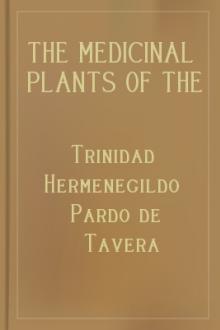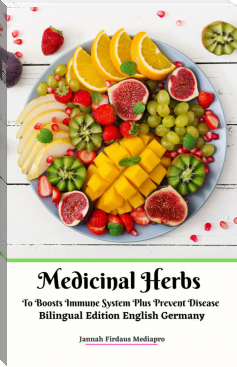The Medicinal Plants of the Philippines by Trinidad Hermenegildo Pardo de Tavera (best pdf ebook reader for android TXT) 📖

- Author: Trinidad Hermenegildo Pardo de Tavera
- Performer: -
Book online «The Medicinal Plants of the Philippines by Trinidad Hermenegildo Pardo de Tavera (best pdf ebook reader for android TXT) 📖». Author Trinidad Hermenegildo Pardo de Tavera
In India the root is employed in the treatment of dysentery.
Botanical Description.—A tree most familiar to every one.
Habitat.—Common in all parts of the Archipelago.
Nipa fruticans, Wurmb.
Nom. Vulg.—Nipa, Sp.-Fil.; Sasa, Tag.
Uses.—The dry leaves of this palm are generally used in the villages of Manila Province, Pampanga, Bulacan and other provinces in the construction of roofs and walls of houses, which are therefore called “nipa houses.” The decoction of the fresh leaves is used as a lotion for indolent ulcers, and a popular preserve is made from the fruit.
Like the coco and following the same process the nipa yields a liquid also called tuba and possessing properties identical with those of the former plant. The weak alcohol distilled from it has some repute in the treatment of conjunctivitis, for which purpose a few drops are mixed with a small quantity of water and the eyes are washed with it several times a day. This alcohol, improperly called wine of nipa, has a characteristically unpleasant odor which makes it impracticable for medicinal or industrial use. Several chemists have attempted to remove the characteristic odor from nipa alcohol, but their results had always been negative because the odorous principle was distilled over at the same temperature as the alcohol. Finally a distinguished Filipino chemist, D. Anacleto del Rosario, perfected a process of producing from the nipa tuba an absolute alcohol perfectly free from the characteristic odor; an alcohol, in fact, possessing all the qualities of chemically pure alcohol, and of such a high grade that it was awarded the first prize at the last World’s Fair in Paris.
Botanical Description.—A palm about 6° high with long, pinnate leaves with leaflets which separate, at maturity, like those of the coco palm. Flowers monœcious, in a spathe. Fruit, many pyramidal drupes joined together, but easily separable. The outer covering of each drupe is hard, the inner part tow-like; seed enveloped in a sort of fleshy white meat.
Habitat.—Salt water marshes, especially in Pampanga and the Visayan Islands.
Sedge Family.
Cyperus rotundus, L.
Nom. Vulg.—Mutha, Tag.; Botobotones, Vis.; Mota, Malaapolid, Sursur, Onoran, Kusug̃, Omadiug̃, Galonalpas, Pam.; Nutgrass or Coco-grass, Eng.
Uses.—The root possesses stimulant, diaphoretic, diuretic and emmenagogue properties. In the Philippines it is used internally for dysentery, and in India for the same purpose and as a vermifuge. It is given as a tonic in gastro-intestinal diseases, and General Hardwick has reported good results with it in cholera; as he reported only two cases, his testimony is not of much value.
The Chinese use the dry or roasted root, especially in inflammation of the viscera and uterine diseases. They also attribute to it diuretic, emmenagogue and anthelmintic properties. In Java and India they use it for gonorrhœa, and in Mauritius as a diaphoretic and astringent. In the Philippines the bruised root is applied to the face for toothache.
Botanical Description.—The root is ovoid, ranging in size from that of a hazel-nut to that of a walnut, composed of a white, spongy substance. Leaves sword-shaped, ensheathing the stem. Flowers in a compound umbel on the end of the stalk which is naked, long and triangular. The umbellets are alternate, awl-shaped, with distinct flowers. Calyx universal, with 2 sword-shaped leaflets. Calyx proper, a very small, ridged scale. Corolla none. Stamens 3. Filaments long, inserted on the base of the ovary. Anthers long and straight. Style 1. Stigmas 3, simple, revolute. Fruit 1. Seed oblong, 3-sided, glabrous.
Habitat.—Common in Luzon and Panay. Blooms in June and July.
Grass Family.
Zea Mays, L.
Nom. Vulg.—Maíz, Sp.; Maize, Corn, Eng.
Uses.—Corn is an extensive article of diet in the Philippines, but has the reputation of being indigestible. This is true when it is eaten in the grain, but in the form of meal it is easily digested and highly nutritious. The tassels have been used in the Philippines from time immemorial in decoction as a diuretic, for which property they received notice in the Medical World of Paris about the year 1876. The entire plant is diuretic and the natives give the decoction of the stalk for various diseases of the bladder and kidneys. An extract of the tassels has been put on the market, but it is better to administer a decoction made from 20 grams of tassel to 1 liter of water to be taken at will during the day. Rademaker and Fischer give the following chemical composition:
The fixed oil is bright yellow, saponifiable by potash, soluble in chloroform and ether, insoluble in alcohol, solidifies at 10°.
Habitat.—Very common in all parts of the islands.
Andropogon Schoenanthes, L.
Nom. Vulg.—Salay, Tag̃lad, Tag.; Paja de Meca, Sp.-Fil.; Baliyoko, Vis.; Geranium Grass, Eng.
Uses.—The Filipino women use the leaves to perfume their gogo hair-wash. The decoction of the leaves is used internally as a diuretic (10 grams to a liter of water) and also to bathe pregnant women. The roots also are diuretic.
A Manila pharmacist, D. Rosendo García, has obtained a good quality of the fixed oil of this plant. In India they call this essence rusa, geranium and gin-gembre (nimar oil, Eng.); the annual export from Bombay is over 40,000 English pounds. It is dextrogyrous and its formula is C5H4.
Another species, the A. nardus, L., commonly called “raiz de mora” (mulberry root), “citronella,” Eng., possesses the same therapeutic properties as the former. It also possesses an agreeable perfume and yields an essential oil, which, like rusa, is used to adulterate Attar of Roses.
The dried root is widely used in the Philippines and in Europe as well, to preserve clothing from moths and other destructive insects, at the same time giving them a sweet odor. In India the decoction is used internally, 10 grams to a liter of water, in the treatment of rheumatism and as a diuretic.
Botanical Description.—An indigenous grass with sword-shaped leaves about 4° high, tapering at the base, possessing a sweet odor. Root thick, irregular, rough, formed by the union of several small rootlets.
Saccharum officinarum, L.
Nom. Vulg.—Cañamiel, Caña de azúcar, Caña dulc, Sp.; Tubo, Tag.; Sugar Cane, Eng.
Uses.—The Filipinos are very fond of the fresh cane. The juice, which is extracted by means of primitive wooden presses, is used as a drink mixed with lemon juice or vino and is sold in markets and public places as a popular beverage on hot days. A tepid juice, extracted from heated cane is given for catarrhal troubles. This use of the juice is the only one peculiar to the Philippines. Its general use and properties are universally familiar and are amply treated in the materia medica.
Botanical Description.—This plant is so universally familiar that it is unnecessary to describe it. More than 20 varieties are found in the Philippines.
Habitat.—Throughout the islands, especially in the Island of Negros and the Luzon Provinces of Pampanga, Bulacan and Nueva Ecija.
Oriza, L.
Nom. Vulg.—Arroz, Sp.; Palay, Tag. (the plant and the unhusked rice); Bigas, Tag. (the husked rice); Rice, Eng.
Uses.—All the people of Indo-China, China, Japan and the greater part of the Indian Archipelago eat rice as Europeans do bread.
In the Philippines an immense variety of rice grows and in the World’s Fair at Paris, in 1889, Señor D. Regino García, of Manila, presented a unique collection of 147 varieties. The rice grown in high lands above irrigation is called “arroz de secano” and mountain rice, and that grown in low and irrigated land is called “arroz de sementera” and swamp rice. The two kinds are equally valuable as food.
The proportion of starch in rice is large, but it contains but a small amount of gluten, and therefore a large amount must be eaten in order to obtain sufficient nutritive elements.
In the Filipino therapeutics rice has an extensive use, especially in the form of a decoction called cange, which is commonly given in the treatment of diarrhœa and dysentery, with good results. Cooked as a sort of mush it may be used as a substitute for linseed poultices and has the great advantage of not becoming rancid. Roasted and powdered it is dusted upon wounds or abrasions of the skin and forms a dry and absorbent covering under which they heal rapidly.
It has lately been claimed that beriberi is due to a microorganism found in rice under certain abnormal conditions; this claim is not yet firmly established and beriberi is still one of the many problems in medicine which are awaiting solution.
Habitat.—All parts of the Archipelago.
Bamboo Family.
Nom. Vulg.—Caña, Sp.; Bamboo, Eng.
Linnæus and Blanco include in the genus Bambus all the different species of bamboo to which the Spaniards have given the general name of caña. The plant is of incomparable value to the natives of the Philippines; they build their houses of it, make agricultural and industrial instruments of it, use it in all the varied apparatus of their fisheries and for a multitude of household utensils and furniture.
The variety B. arundinacea, Retz. (B. arundo, Blanco), Kawayag-totóo, Tag., is the largest and most generally employed in making houses and furniture. The tender shoots prepared in lime water are edible but have the deserved reputation of being difficult of digestion.
The variety Schizostachyum acutiflorum, Munro (B. diffusa, Blanco), Osiw, Bokawy, Tag., is less used. The shoots are used to treat opacity of the cornea, for which purpose they are cut when about a palm in height, the outer leaves removed, and the center soaked over night with a little sugar candy. The following day the water in the bottom of the jar is collected and used to paint the cornea.
The variety Dendrocalamus sericens, Munro (B. mitis, Blanco), Taywanak, Tag., is also used in medicine. Its abundant sap is given internally in the treatment of phthisis.
All of the above species and the Dendrocalamus flagellifer, Munro (B. levis, Blanco), Boho, Tag., produce at their joints a hard porcelain-like substance, friable, of opaline color, called “bamboo stone” or “tabashir” in India, where, as well as in the Philippines and Indo-China, it has great repute among the popular remedies. It is given in venereal diseases, hiccough, hemorrhage, fevers and other diseases. As a matter of fact, it is an almost inert substance, the imaginary virtues of which originated, doubtless, in the apparently remarkable fact that a stone (?) was produced inside of a vegetable.
The analysis of M. Guibourt is as follows:
1 European analyses make the amount 1–2.2 per cent.
Alteratives.—Anona muricata.—Tinospora crispa.—Raphanus sativus.—Bombax malabaricus.—Oxalis corniculata.—Citrus acida and C. Bigaradia.—Mangifera Indica.—Pongamia glabra.—Lawsonia alba.—Hydrocotyle Asiatica.—Alangium Lamarkii.—Oldenlandia corymbosa.—Calotropis gigantea.—Ehretia buxifolia.—Solanum nigrum.—Cassytha filiformis—Euphorbia Tirucalli.—Phyllanthus reticulatus.
Anthelmintics.1—Cleome viscosa.—Pangium edule.—Ruta graveolens.—Melia Azedarach.—Dysoxylum Blancoi.—Mangifera Indica.—Anacardium occidentale.—Mucuna pruriens.—Quisqualis Indica.—Punica Granatum.2—Jussiæa suffruticosa.—Carica Papaya.—Trichosanthes anguina and T. cucumerina.—Lagenaria.—Momordica.—Hydrocotyle Asiatica.—Sphæranthus Indicus.—Calotropis gigantea.—Tectona grandis.—Clerodendron infortunatum.—Chenopodium ambrosioides.—Echinus Philippinensis.—Cyperus rotundus.—Rhinacanthus communis.
Antispasmodics.—Sida carpinifolia.—Hibiscus Abelmoschus.—Ruta graveolens.—Citrus acida and C. Bigaradia.—Cedrela Toona.—Celastrus paniculata.—Cassia occidentalis.—Carum





Comments (0)